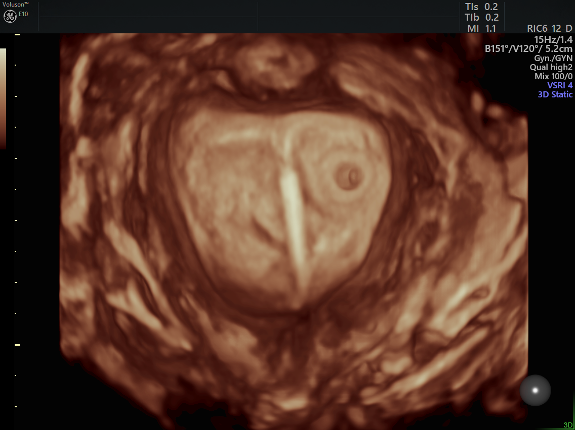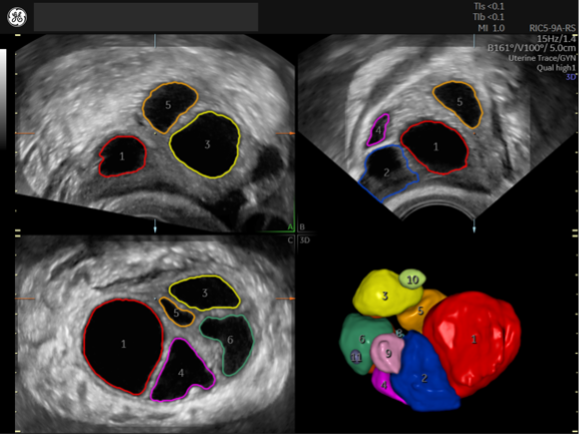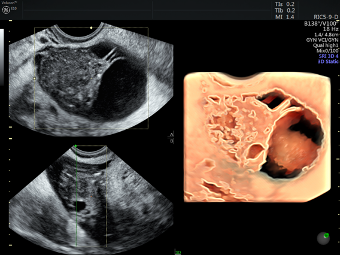Ultrasound technology has advanced rapidly in the past decade, and the convenient features offered by newer models are becoming mainstays of OB/GYN practice. With decision support tools and ergonomic design, it is easier than ever to incorporate ultrasound into routine OB/GYN exams and give patients a safe, cost-effective option for finding answers about their health.
How Ultrasound Simplifies Routine Gynecologic Practice
Patients today are more engaged with their providers than ever, seeking shared decision-making and eager to understand exam results. Gynecological ultrasound is a safe form of imaging that involves no radiation exposure and is already familiar to many. As a first-line evaluation option, ultrasound offers physicians a wealth of information before they consider referring a patient for more invasive or costlier tests.
The ability to angle the screen or swivel the console make it easier to review exam results in real time and explain what is on the screen — and what it means — to patients. This can increase patients' trust and confidence in the exam room. Machines with an image sharing tool let you easily share the findings with patients as well as with other members of the care team, such as a urogynecologist or the patient's primary care provider.
Newer models are increasingly easy to use thanks to features such as touch screens, processes that require fewer keystrokes to enter or find information and integrated decision support tools. Finding a model with the right features helps simplify routine practices. Units with streamlined processes, intuitive user interfaces and customizable menus let you put the information you need at the forefront. Features aimed at a better user experience help shorten the learning curve as you expand your practice's ultrasound offerings.
Using Ultrasound for Routine OB/GYN Exams
Ultrasound can provide a wealth of information for patients at all stages of life, from adolescence to beyond menopause. Here are some ways to incorporate ultrasound into routine gynecologic exams.
Understanding Pelvic Pain
Pelvic pain is one of the most common complaints that lands women in the OB/GYN office. It is also nonspecific, and it may or may not have a gynecologic cause. In addition to a physical examination, medical history and blood tests, an ultrasound can help diagnose the source of the pain (or at least exclude some possibilities). Ultrasound may help uncover endometriomas in teenagers or polycystic ovarian syndrome (PCOS) in older women.
Locating an IUD
Intrauterine devices (IUDs) have become the most commonly used form of long-term reversible birth control, according to Archives of Gynecology and Obstetrics. But it is possible for them to be malpositioned during insertion or to move out of position later on, causing pain, heavy bleeding and other symptoms. An IUD may also be partially expelled, rotate or become embedded. A 3D ultrasound provides an accurate way to locate a malpositioned IUD by visualizing the coronal plane. An ultrasound can also help evaluate the uterus before placing the IUD or assist with finding and removing an IUD when the strings are not visible.

Intrauterine Pregnancy with IUD
Evaluating Infertility
About 12 percent of women in the United States experience infertility, according to the Centers for Disease Control and Prevention. Ultrasound aids in diagnosing issues that cause difficulty getting pregnant, such as PCOS, pelvic inflammatory disease, endometriosis, polyps and fibroids. Support tools within the ultrasound can provide measurements of masses or endometrial thickness to inform your treatment approach. Transvaginal or saline infusion ultrasound can pinpoint uterine anomalies and visualize the shape of the uterus to determine other possible causes of infertility or recurrent miscarriage.

Bicornate Uterus
An ultrasound may not yield a definitive answer every time, but it will provide a treasure trove of information in a short amount of time so you can begin discussing next steps with your patients.
Monitoring Fertility Treatments and IVF
After uncovering a cause of infertility, ultrasound is key to monitoring progress — for example, shrinking fibroids. Ultrasound is also vital throughout many stages of in vitro fertilization (IVF), including evaluation, monitoring, procedures and pregnancy confirmation. Ultrasound measures endometrial thickness, and 3D color Doppler ultrasound aids in determining endometrial vascularity, both valuable measures for embryo transfer.

Voluson SonoAVC follicle automates follicle monitoring during IVF
Assessing Abnormal Bleeding or Irregular Menstrual Cycles
Abnormal bleeding or irregular cycles are another common but nonspecific complaint among patients. Ultrasound is a way to gather information relatively easily and create opportunities for detailed discussions with patients about their health. It is a non-invasive option for patients at all stages in life, well suited to both looking for PCOS in adolescents and measuring endometrial thickness in postmenopausal women. Information from the ultrasound can also clarify the need for further, more invasive or more expensive diagnostic exams.
Evaluating Pelvic Masses
Ultrasound remains the first-line option for assessing ovarian lesions; advanced models offer tools such as the IOTA (International Ovarian Tumor Analysis): LR2, Simple Rules and ADNEX Model, which provide ovarian cancer risk estimate guidance. These tools ensure quality and consistency to help inform treatment decisions. After a diagnosis, ultrasound may also be part of treatment, as many procedures are performed under ultrasound guidance.

Adnexal Mass

Ovarian Mass
Ultrasound gives OB/GYNs more opportunities to find answers for patients and engage them in their care. Ultrasound machines not only offer innovative imaging tools but are also designed to include ergonomic features such as adjustable height, fewer buttons and knobs and a lighter overall unit. That allows physicians, nurses and sonographers to maintain better posture and experience less fatigue in high-volume settings.
Incorporating ultrasound more often into routine OB/GYN exams also lays a foundation to recoup the initial investment of a new unit more quickly. Performing initial screenings and evaluations with ultrasound rather than with alternative imaging exams (such as MRI or CT scans, which often need to be referred out) keeps your patients in your practice. Ultimately, it is more convenient for them and for you. When determining the best investment, look for a model designed with features attuned to what works best for your practice workflow.
Interested in learning more about ground-breaking ultrasound technology? Learn about the Voluson SWIFT ultrasound product.



